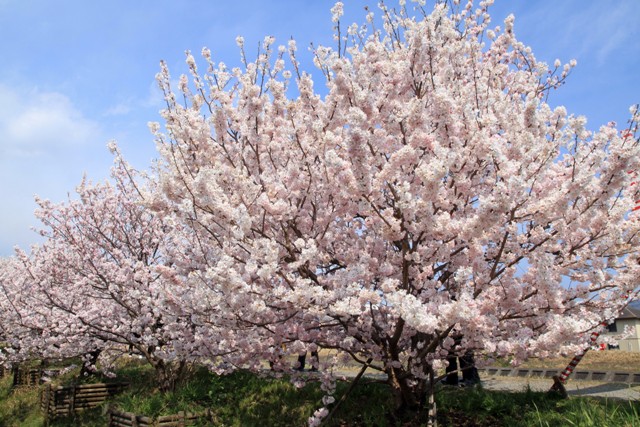5506F of the EMU Izu-Hakone 5000 series arrives at Odawara station
I recently took the Daiyuzan line of Izu-Hakone Railway with my family for the first time in two years. Our destination was Fujifilm-mae station as we visited a cherry-tree-lined path named Harukimichi near the station.
It was still the middle of March but the cherry trees were already fully blooming there. It was too early. Why? It was because the cherry blossoms of Harukimichi are early blooming species called Harumeki-sakura. This precious species was developed by the local people 19 years ago. Its blooming season is later than Kawazu-sakura (Kawazu cherry) but earlier than Someiyosino (ordinary cherry) so that Harumeki-sakura acts as an intermediary between two kinds of cherries.
To get to Fujifilm-mae station, our vehicle was the EMU Izu-Hakone 5000 series. It is the sole model on the Daiyuzan line. A total of 7 sets, 21 units were built by Tokyu Sharyo (present J-TREC) from 1984 to 1996. Only the 1st set (5501F) is steel, while the other 6 sets (5502F to 5507F) are stainless-steel. One set consists of 2 motorcars and 1 trailer (2M1T). The electric control system is a rheostatic with an electric power generation brake.
For your information, the Daiyuzan Line was opened in 1925 between Odawara and Daiyuzan stations. It was constructed to transport worshippers to the famous Saijo-ji Temple. The route length is 9.6 km. The track is 1,067 mm-size single and electrified. The electric system is 1,500 V DC overhead. Trains are operated every 12 minutes on average.
It was still the middle of March but the cherry trees were already fully blooming there. It was too early. Why? It was because the cherry blossoms of Harukimichi are early blooming species called Harumeki-sakura. This precious species was developed by the local people 19 years ago. Its blooming season is later than Kawazu-sakura (Kawazu cherry) but earlier than Someiyosino (ordinary cherry) so that Harumeki-sakura acts as an intermediary between two kinds of cherries.
To get to Fujifilm-mae station, our vehicle was the EMU Izu-Hakone 5000 series. It is the sole model on the Daiyuzan line. A total of 7 sets, 21 units were built by Tokyu Sharyo (present J-TREC) from 1984 to 1996. Only the 1st set (5501F) is steel, while the other 6 sets (5502F to 5507F) are stainless-steel. One set consists of 2 motorcars and 1 trailer (2M1T). The electric control system is a rheostatic with an electric power generation brake.
For your information, the Daiyuzan Line was opened in 1925 between Odawara and Daiyuzan stations. It was constructed to transport worshippers to the famous Saijo-ji Temple. The route length is 9.6 km. The track is 1,067 mm-size single and electrified. The electric system is 1,500 V DC overhead. Trains are operated every 12 minutes on average.

